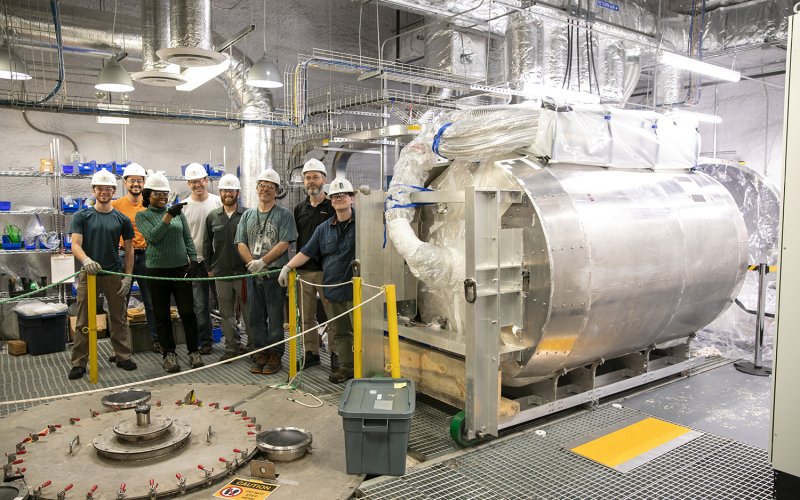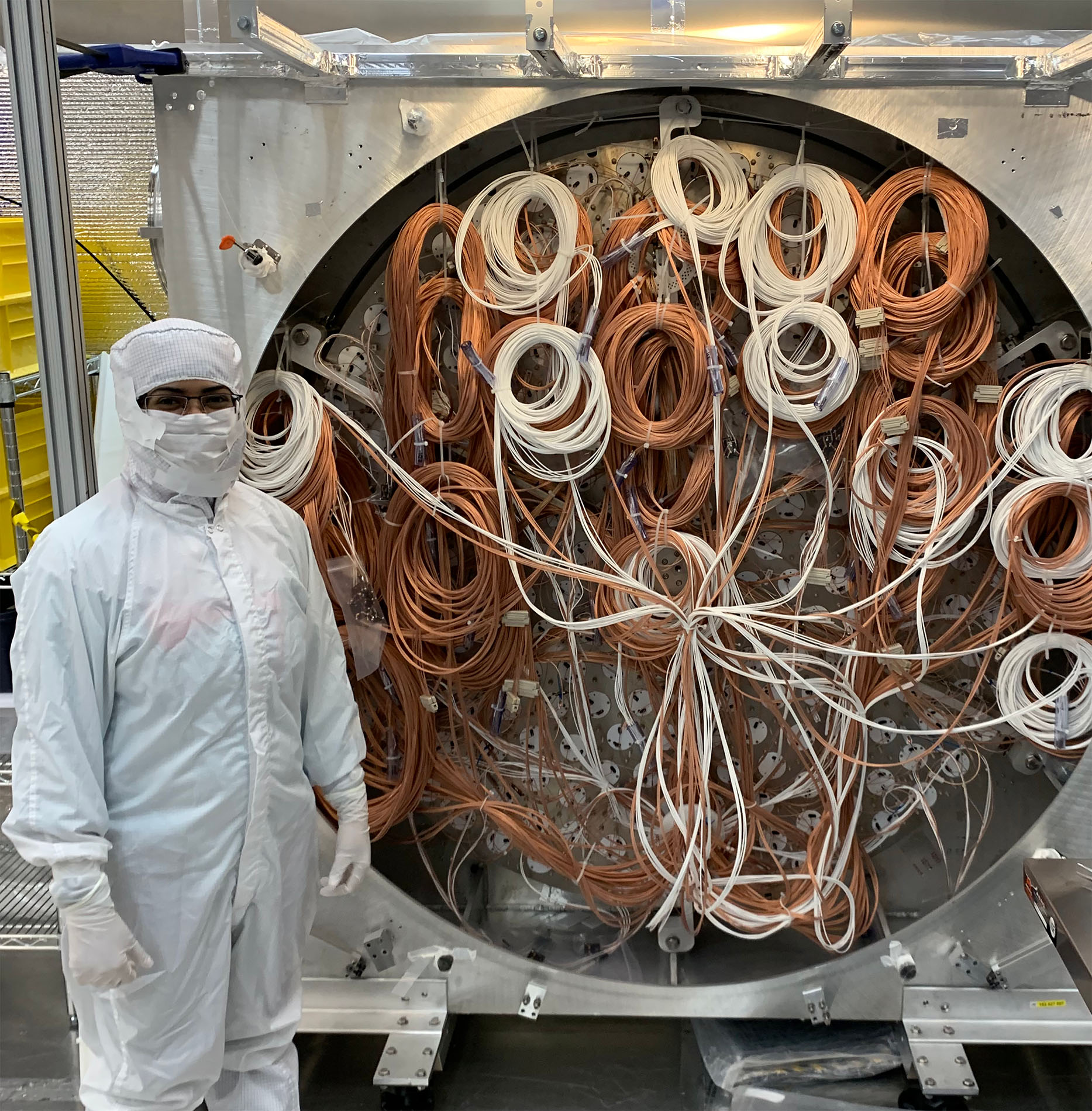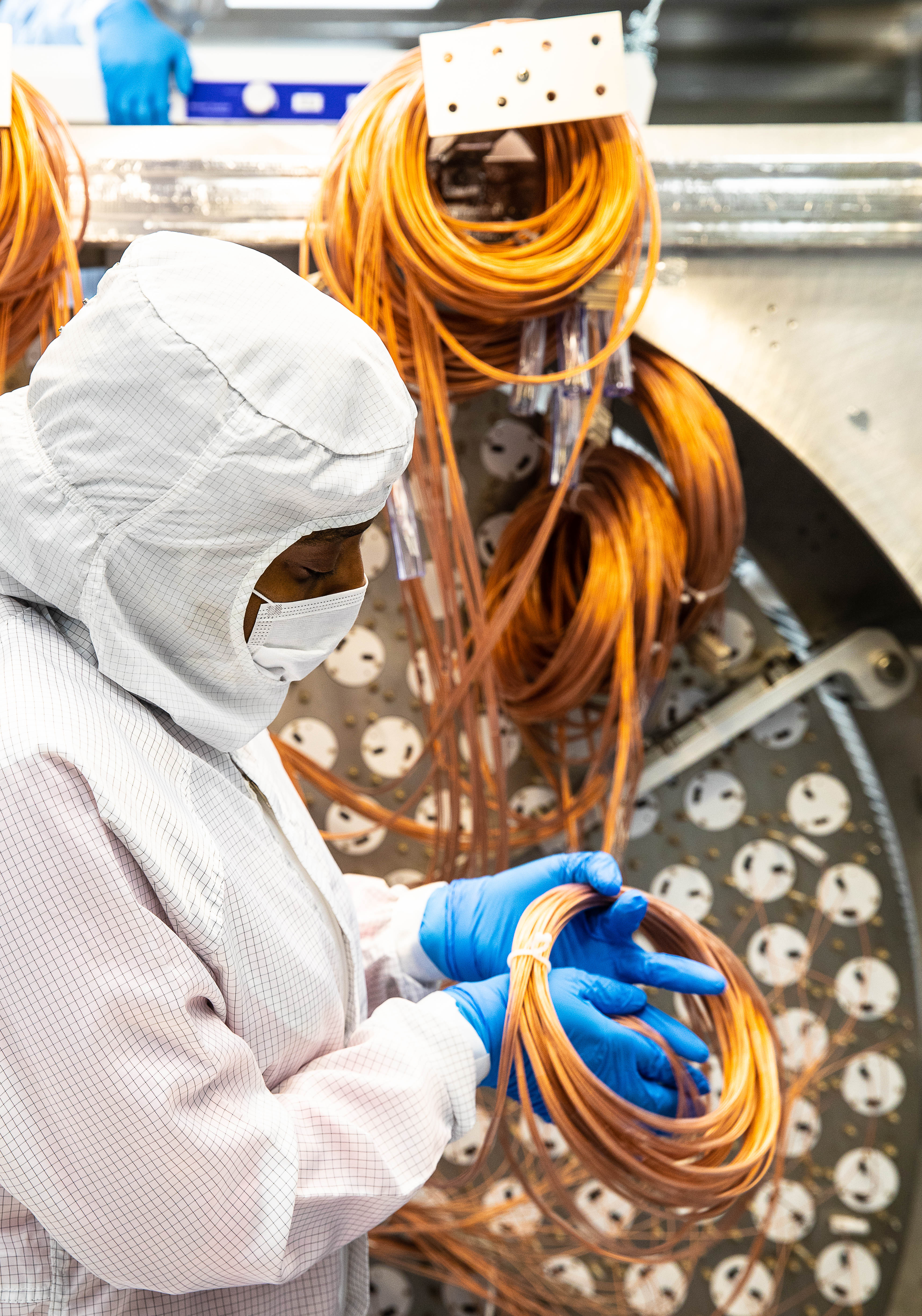UAlbany Scientists Hail Successful Startup of LUX-ZEPLIN

ALBANY, N.Y. (July 8, 2022) — Deep below the Black Hills of South Dakota in the Sanford Underground Research Facility (SURF), an innovative and uniquely sensitive dark matter detector — the LUX-ZEPLIN (LZ) experiment, led by Lawrence Berkeley National Lab (Berkeley Lab) — has passed a check-out phase of startup operations and delivered first results.
In a paper posted online on the experiment’s website, LZ researchers report that with the initial run, LZ is already the world’s most sensitive dark matter detector.
The design, manufacturing and installation phases of the LZ detector were led by Berkeley Lab project director Gil Gilchriese in conjunction with an international team of 250 scientists and engineers from over 35 institutions from the United States, United Kingdom, Portugal and South Korea, including University at Albany Assistant Professor Cecilia Levy and Associate Professor Matthew Szydagis. The collaboration hopes to use the instrument to record the first direct evidence of dark matter, the so-called missing mass of the cosmos.
“I’m so pleased with the success of this detector. After years of planning, design, and assembly, it came together beautifully and is really working remarkably well,” said Levy, LZ principal investigator at UAlbany “I am looking forward to the trove of data we will get from it in the years to come.”
Levy, together with co-PI Szydagis, have led a team of postdoctoral researchers and PhD graduate students at UAlbany since 2017.
Dark matter particles have never actually been detected — but perhaps not for much longer. The countdown may have started with results from LZ’s first 60 “live days” of testing. These data were collected over a three-and-a-half-month span of initial operations beginning at the end of December. This was a period long enough to confirm that all aspects of the detector were functioning well.
Unseen, because it does not emit, absorb or scatter light, dark matter’s presence and gravitational pull are nonetheless fundamental to our understanding of the universe. For example, the presence of dark matter, estimated to be about 85 percent of the total mass of the universe, shapes the form and movement of galaxies, and it is invoked by researchers to explain what is known about the large-scale structure and expansion of the universe.
The heart of the LZ dark matter detector is comprised of two nested titanium tanks filled with 10 tonnes of very pure liquid xenon and viewed by two arrays of photomultiplier tubes (PMTs) able to detect faint sources of light. The titanium tanks reside in a larger detector system to catch particles that might mimic a dark matter signal.
Between 2014-16 Szydagis worked on LZ with Levy as his postdoctoral scholar, while prior to 2014 both Levy and Szydagis collected multiple years of experience on similar earlier experiments XENON100 and LUX as graduate students and postdocs themselves at different institutions.

“With two faculty on LZ at UAlbany, we can really contribute meaningfully to the experiment. The two groups are really intertwined and intimately integrated, making one cohesive dark matter group.” said Levy, who currently mentors physics PhD student Nishat Parveen, while Szydagis mentors student Greg Blockinger.
They co-mentor postdoctoral researcher Greg Rischbieter, Szydagis’ former PhD student on LZ. Former postdoctoral researchers in the UAlbany dark matter group include Jeremy Mock, now a software engineer at SLAC National Accelerator Laboratory, and Alvine Kamaha, now an assistant professor at UCLA on LZ.
An underground detector
Tucked away about a mile underground at SURF in Lead, S.D., LZ is designed to capture dark matter in the form of Weakly Interacting Massive Particles (WIMPs). The experiment is underground to protect it from cosmic radiation at the surface that could drown out dark matter signals.
“Particle collisions in the xenon produce visible scintillation or flashes of light, which are recorded by the PMTs," explained Aaron Manalaysay from Berkeley Lab who, as physics coordinator, led the collaboration’s efforts to produce these first physics results. “The collaboration worked well together to calibrate and to understand the detector response."
The collisions will also knock electrons off xenon atoms, sending them to drift to the top of the chamber under an applied electric field where they produce another flash, permitting spatial event reconstruction. The characteristics of the scintillation help determine the types of particles interacting in the xenon.
These characteristics can be simulated with the assistance of the computer model and software package NEST (Noble Element Simulation Technique) developed by Szydagis.
The South Dakota Science and Technology Authority, which manages SURF through a cooperative agreement with the U.S. Department of Energy, secured 80 percent of the xenon in LZ. Funding came from the South Dakota Governor’s office, the South Dakota Community Foundation, the South Dakota State University Foundation and the University of South Dakota Foundation.
“The design, construction and commissioning of the detector was a massive undertaking. Many subsystems had to come together perfectly to make it work, which required an impressive level of coordination,” said Levy. “The hard work paid off. This really was a team effort.”
Kamaha, a former postdoctoral researcher at UAlbany, played an integral role during assembly and, later, as calibration coordinator of the experiment.

"It was a lot of work managing key aspects of the success of this great experiment," said Kamaha. "All this effort paid off as shown by our first results. I am proud to say that I was instrumental in building the world's biggest, cleanest and most sensitive dark matter detector and that we set a standard for the dark matter field going forward."
Kamaha co-led the surface contamination control program of the experiment, then led the installation and commissioning of its calibration systems during her post-doctoral tenure at UAlbany.
"My time at UAlbany working with Prof. Levy was decisive for my career," Kamaha continued. "I appreciate the leadership opportunities she set me up for."
Szydagis also noted, “The NEST simulation was able to match data with minimal tuning, at the sub 1 percent level, indicating that our models of the data make sense.”
His graduate students Rischbieter (now postdoc) and Blockinger played critical roles in ensuring that simulations were a faithful representation of real data, while Levy’s student Parveen focused on the definition of the detector wall in data analysis and the boundaries of the active volume.
“We have overwhelming amounts of evidence that dark matter is out there, from astronomy, cosmology and astrophysics,” said Szydagis. “That does not mean it is easily detectable, but I am optimistic about detection in the near future.”
“It’s like looking for a very, very fine needle in a very, very big haystack,” said Levy. “It’s difficult, but eventually, we’re going to find it. With LZ, we’re now in a very good place to do so.”
LZ is supported by the U.S. Department of Energy, Office of Science, Office of High Energy Physics and the National Energy Research Scientific Computing Center, a DOE Office of Science user facility. LZ is also supported by the Science & Technology Facilities Council of the United Kingdom; the Portuguese Foundation for Science and Technology; and the Institute for Basic Science, Korea. The LZ collaboration acknowledges the assistance of the Sanford Underground Research Facility.




